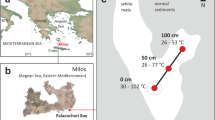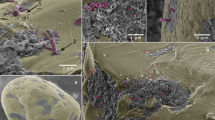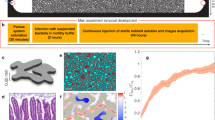Abstract
Solute uptake by microorganisms is limited by molecular diffusion through a boundary layer surrounding the cells, and the uptake is not enhanced (or only insignificantly) by convective water transport or by swimming1. It is generally assumed that sediment uptake of oxygen is diffusion-limited, so the steepness ofthe concentration gradient within the 0.5–1-mm-thick diffusive boundary layer is a measure of diffusional flux into thesediment2,3. Here we show that veils, which are formed onsediments by the marine sulphide-oxidizing bacterium Thiovulum majus4, generate convective oxygen transport through the 0.5-mm-thick water layers above the veil at rates that are about 40 times higher than molecular diffusion. Chemosensory behaviour of the cells, combined with their generation of water currents, leads to characteristic, aggregated distribution patterns: areas with high cell densities draw oxygenated water downwards through the veil, whereas areas without cells serve for the upward-directed return flow of deoxygenated water. The microbial community structure thus overcomes the limitations of diffusion and thereby enhances the rates of respiration and sulphide oxidation.
This is a preview of subscription content, access via your institution
Access options
Subscribe to this journal
Receive 51 print issues and online access
$199.00 per year
only $3.90 per issue
Buy this article
- Purchase on Springer Link
- Instant access to full article PDF
Prices may be subject to local taxes which are calculated during checkout




Similar content being viewed by others
References
Purcell, E. M. Life at low Reynolds number. Am. J. Phys. 45, 3–11 (1977).
Revsbech, N. P., Jørgensen, B. B. & Blackburn, T. H. Oxygen in the sea bottom measured with a microelectrode. Science 207, 1355–1356 (1980).
Revsbech, N. P. & Jøgensen, B. B. Microelectrodes: their use in microbial ecology. Adv. Microbiol. Ecol. 9, 293–352 (1986).
Wirsen, C. O. & Jannasch, H. W. Physiological and morphological observations on Thiovulum sp. J. Bacteriol. 136, 765–774 (1978).
Garcia-Pichel, F. Rapid bacterial swimming measured in swarming cells of Thiovulum majus. J. Bacteriol. 171, 3560–3563 (1989).
Fenchel, T. Motility and chemosensory behaviour of the sulphur bacterium Thiovulum majus. Microbiology 140, 3109–3116 (1994).
Jørgensen, B. B. & Revsbech, N. P. Colorless sulfur bacteria, Beggiatoa spp. and Thiovulum spp. in O2and H2S microgradients. Appl. Environ. Microbiol. 45, 1261–1270 (1983).
Lighthill, J. Flagellar hydrodynamics. Soc. Indust. Appl. Math. Rev. 18, 161–230 (1976).
Vogel, S. Life in moving fluids (Grant, Boston, 1981).
Fenchel, T. & Bernard, C. Mats of colourless sulphur bacteria. I Major microbial processes. Mar. Ecol. Prog. Ser. 128, 161–170 (1995).
Aller, R. C. & Yingst, J. Y. Effects of marine deposit-feeders Heteromastus filiformis (Polychaeta), Macoma balthica (Bivalvia), and Tellina texana (Bivalvia) on averaged solute transport, reaction rates, and microbial distributions. J. Mar. Res. 41, 299–322 (1985).
Dando, P. R. et al. The effects of methane seepage at an intertidal/shallow subtidal site on the shore of Kattegat, Vendsyssel. Bull. Geol. Soc. Denmark 41, 65–79 (1994).
Gundersen, J. K., Jørgensen, B. B., Larsen, E. & Jannasch, H. W. Mats of giant sulphur bacteria on deep-sea sediments due to fluctuating hydrothermal flow. Nature 360, 454–455 (1992).
Glud, R. N., Gundersen, J. K., Revsbech, N. P. & Jørgensen, B. B. Effects on the benthic diffusive boundary layer imposed by microelectrodes. Limnol. Oceanogr. 39, 462–467 (1994).
Acknowledgements
We thank J. Johansen for technical assistance. This study was supported by grants from the Danish Natural Science Research Council.
Author information
Authors and Affiliations
Corresponding author
Rights and permissions
About this article
Cite this article
Fenchel, T., Glud, R. Veil architecture in a sulphide-oxidizing bacterium enhances countercurrent flux. Nature 394, 367–369 (1998). https://doi.org/10.1038/28609
Received:
Accepted:
Issue Date:
DOI: https://doi.org/10.1038/28609
This article is cited by
-
Resource availability shapes microbial motility and mediates early-stage formation of microbial clusters in biological wastewater treatment processes
Applied Microbiology and Biotechnology (2014)
-
Two-Dimensional Patterns in Bacterial Veils Arise from Self-generated, Three-Dimensional Fluid Flows
Bulletin of Mathematical Biology (2011)
Comments
By submitting a comment you agree to abide by our Terms and Community Guidelines. If you find something abusive or that does not comply with our terms or guidelines please flag it as inappropriate.



